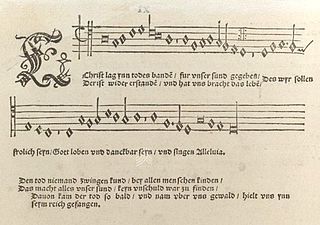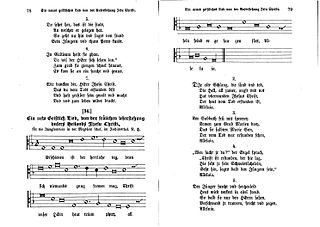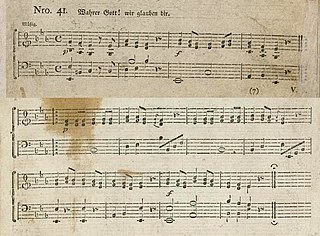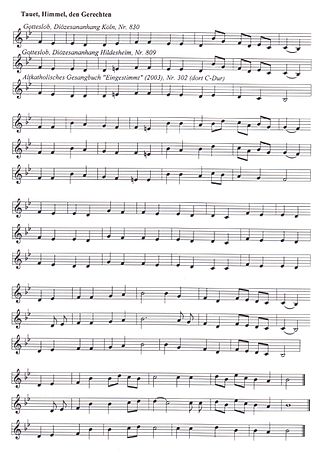
"Christ lag in Todesbanden" is an Easter hymn by Martin Luther. Its melody is by Luther and Johann Walter. Both the text and the melody were based on earlier examples. It was published in 1524 in the Erfurt Enchiridion and in Walter's choral hymnal Eyn geystlich Gesangk Buchleyn. Various composers, including Pachelbel, Bach and Telemann, have used the hymn in their compositions.

"Gott sei gelobet und gebenedeiet" is a Lutheran hymn of 1524 with words written by Martin Luther who used an older first stanza and melody. It is a song of thanks after communion. Luther's version in three stanzas was printed in the Erfurt Enchiridion of 1524 and in Johann Walter's choral hymnal Eyn geystlich Gesangk Buchleyn the same year. Today, the song appears in German hymnals, including both the Protestant Evangelisches Gesangbuch, and in a different version in the Catholic Gotteslob.

Gotteslob is the title of the hymnbook authorized by the Catholic dioceses in Germany, Austria, South Tyrol, Luxembourg and Liège, Belgium. First published in Advent 2013, it is the current official hymnal for German-speaking Catholics, succeeding the first common German hymnal, the 1975 edition of the same name. Each diocese published a book containing a common section and a regional section. The first editions amounted to around 4 million copies.

"Allein Gott in der Höh sei Ehr" is an early Lutheran hymn, with text and melody attributed to Nikolaus Decius. With the reformers intending church service in German, it was intended as a German version of the Gloria part of the Latin mass, used in almost every service. Decius wrote three stanzas, probably in 1523, while a fourth was added, probably by Joachim Slüter.
"Der Geist des Herrn erfüllt das All" is a Christian hymn for Pentecost by Maria Luise Thurmair, written in 1941. First printed in 1946, it appeared with a 1609 melody by Melchior Vulpius in the German Catholic hymnal Gotteslob in 1975 as GL 249. It has been included in ecumenical hymnals and songbooks.

"Was mein Gott will, das g'scheh allzeit" is a Lutheran hymn in German. The text from c. 1550 is attributed to Albert, Duke of Prussia. The melody, Zahn No. 7568, goes back to a tune by Claudin de Sermisy, written in 1529 for a secular French song. The hymn has belonged to core Lutheran hymnody without interruption and is part of the Protestant hymnal Evangelisches Gesangbuch as EG 364.

"Erschienen ist der herrlich Tag" is a German Easter hymn, with text and tune written by Nikolaus Herman and published in 1561. It has inspired musical settings by composers from the 17th to the 20th century. It appears in several hymnals, including the German Protestant hymnal Evangelisches Gesangbuch. Other hymns, especially Easter hymns, in both German and English, are sung to the same melody.

"Macht hoch die Tür" is a popular German Advent hymn, written in 17th century Ducal Prussia. The lyrics were written by Georg Weissel in 1623 for the inauguration of the Altroßgärter Kirche in Königsberg. The melody that is now associated with the text appeared first in 1704 in the hymnal by Johann Anastasius Freylinghausen.

"Christ fuhr gen Himmel" is a German Ascension hymn. The church song is based the medieval melody of the Easter hymn "Christ ist erstanden". It was an ecumenical song from the beginning, with the first stanza published in 1480, then included in a Lutheran hymnal in 1545, and expanded by the Catholic Johannes Leisentritt in 1567. It appears in modern German Catholic and Protestant hymnals, and has inspired musical settings by composers from the 16th to the 21st century.

Johann Franz Seraph von Kohlbrenner was a German polymath, promoting the Enlightenment in Bavaria. While working as a civil servant for the Bavarian court, he published a hymnal which contained a complete German High Mass and songs such as "Das Grab ist leer, der Held erwacht" for which he is known. These hymns and especially his German mass, used in settings by Michael Haydn, remain popular to this day.

""Wahrer Gott, wir glauben dir" is a Catholic hymn. Christoph Bernhard Verspoell (1743–1818), a cleric from Münster, wrote text and melody, and published it in 1810 in his hymnal Orgelbegleitung zu den Gesängen beym Römisch-kathol. Gottesdienste. Herausgegeben von C. B. Verspoell. The song in two stanzas has remained in the repertory of church hymns, used mainly during Eastertide, but also for communion and funerals. It appears in several regional sections of the Catholic hymnal Gotteslob, as GL 770 in Cologne, as GL 780 in Limburg and Münster, and as GL 783 in Speyer, among others.

Deutsches Hochamt is the title common to several mass compositions by Michael Haydn, setting the mass ordinary in German by Franz Seraph von Kohlbrenner. Three of the works require trained singers and orchestra, while a fourth is kept simple to be sung by the congregation as a Deutsche Singmesse (Betsingmesse). His best-known German High Mass is catalogued as MH 560. Haydn's masses in German are also known by the incipit of the first of ten songs, "Hier liegt vor deiner Majestät".
"Nun lässest du, o Herr" is a Christian hymn by Georg Thurmair written in 1966 as a paraphrase of the Nunc dimittis canticle. It was part of the German Catholic hymnal Gotteslob of 1975 as GL 660 with a 16th-century melody by Loys Bourgeois. With this melody, it is also part of the Protestant hymnal Evangelisches Gesangbuch as EG 695. It is part of the second edition of the Gotteslob as GL 500, with a new 1994 melody.
"O Licht der wunderbaren Nacht" is a Christian Easter hymn by Georg Thurmair written in 1963. It was part of the German Catholic hymnal Gotteslob of 1975 as GL 208, with a melody from the 14th century. It is part of the second edition of the Gotteslob as GL 334, also of regional sections of the Protestant hymnal Evangelisches Gesangbuch.
"Das Jahr steht auf der Höhe" is a Christian hymn in German with a text by Detlev Block written in 1978 to an older melody by Johann Steuerlein. In the modern German Catholic hymnal Gotteslob, it appears as GL 465. The hymn initially focuses on observing nature and then compares its transience to that of human life.

Cantate! (Sing!) is a German Catholic hymnal first published in 1847, and continued in seven editions until 1879. It was a collection of 444 old and new songs, edited by the educator and hymnwriter Heinrich Bone, and the first Catholic hymnal in German that was used in multiple dioceses. Several of the songs are still part of the common Catholic hymnal in the Germanosphere, Gotteslob.

"Mit Ernst, o Menschenkinder" is an Advent hymn by Valentin Thilo. It partly paraphrases the call to penitence by John the Baptist. The text was first published in 1642 in the collection Preußische Festlieder. The different melody that later became popular dates back to 1557.
"Herr, mach uns stark" is a Christian hymn in German with text by Anna Martina Gottschick written in 1972. The hymn for the end of the church year is sung to the melody "Sine Nomine" by Ralph Vaughan Williams. It is contained in the Catholic hymnal Gotteslob, concluded with an added sixth stanza by Jürgen Henkys. The first line is "Herr, mach uns stark im Mut, der dich bekennt".
"Öffnet eure Tore" is a Christian hymn in German, written by Christoph Bernhard Verspoell for the Feast of the Ascension. The text is based on Psalm 24. While the text was written in Münster in 1810, the melody was composed for a Trier hymnal of 1846. It became part of the regional sections of the German Catholic hymnal Gotteslob.

"Tauet, Himmel, den Gerechten" is an Advent hymn in German, in the Catholic tradition of the Rorate masses.















